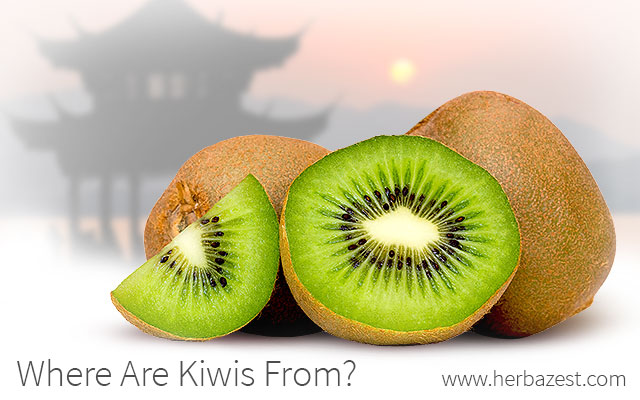Kiwi has been identified by many names, separated into numerous cultivars, and grown in different regions all over the world. All of these factors have encouraged great research into kiwi's origin and evolution over the years.
Origins of the Kiwi Fruit
While the kiwi fruit holds strong ties with New Zealand, the Actinidia genus actually originated in China. In fact, kiwi scientific name is A. chinensis and it was formerly known as Chinese gooseberry. The kiwi fruit has been cultivated in the Asian country for at least 300 years, and it is thought to first naturally occur in northern China, along the Yangtze River Valley, and also in the Zhejiang Province on the coast of eastern China. Most of the cultivated crop yield comes from 33 of the province's 48 counties.
One reason why most of the kiwis are from the same area is because of the fruit's very specific climate requirements. Kiwi fruit growth requires fertile soils, temperate weather, and adequate moisture year-round. Actinidia species' growing habitat must allow for some wind for pollination, but enough shelter to prevent damage to the tall-climbing plants.
The growth habits of Chinese kiwi fruit do differ depending on the region. Near Lung, kiwi plants climb up the tall trees, whereas in Hupeh, the plants spread over low bush or rocks, baring themselves to the strong northeast winds.
Though Actinidia chinensis was considered to be a delicacy by the Khans due it its emerald green color and luxurious flavor, the Chinese kiwi fruit was not exploited for commercial purposes.
WHILE THE KIWI PLANT IS NATIVE TO CHINA, ITS WIDE EXPANSION IS CREDITED TO NEW ZEALAND, EUROPE, AND THE UNITED STATES.
Evolution of Kiwi
The cultivation of kiwi in New Zealand began around 1905, when Chinese missionaries brought kiwi seeds believed to be from Hubei or Sichuan. The seeds were cultivated and vines began producing fruits by 1910. The popularity of kiwifruit rose as local nurserymen realized the potential of the fruit and began growing it as a backyard vine.
In 1920, grafted plants - two plants joined to appear as one - were first sold, which increased variation and led to the propagation of good strains of kiwifruit from New Zealand. These ideal fruits were big, oval or elongated kiwis with bright green flesh and no hard core.
Once plant growth had developed, kiwi plants - or Chinese gooseberries as they were called at the time - were renamed as kiwi fruit after New Zealand's fuzzy brown national bird, and sent to California.
CALIFORNIA BEGAN CULTIVATING ITS OWN KIWI FRUIT IN THE DELANO AND GRIDLEY AREAS IN THE LATE 1960s.
The most common and widely popular cultivar of kiwi, called 'Hayward', originated in New Zealand under the nurseryman Hayward Wright. The 'Hayward' vine has dominated the kiwi market in New Zealand, California, and Europe, which has led to standardization and increased competition.
While other nations such as Italy, South Africa, and Chile have joined in the commercial market over the years, New Zealand remains the largest distributing country of kiwi fruit.
ACTINIDIA DELICIOSA IS NOW CONSIDERED TO BE DIFFERENT THAN THE ASIAN ACTINIDIA CHINENSIS, AND IT IS IDENTIFIED AS A SPECIES NATIVE TO NEW ZEALAND, FROM WHERE MOST KIWI FRUITS COME NOWADAYS.
Interestingly enough, China - where kiwi originates - only began commercial cultivation approximately 25 years ago. However, by 1998, there were 45,000 hectares of kiwi orchards.
The answer to the question of where is kiwi from is not as clear as it may seem, since New Zealand has developed a distinctive kiwi varieties and many cultivars. From its wild origins in China 300 years ago to its cultivation and spread worldwide, the Actinidia genus has definitely evolved. Regardless where kiwi fruits are from, their popularity continues to skyrocket, and their cultivation is expected to grow even further.
Sources
- California Rare Fruit Growers, Kiwifruit
- Edible Medicinal And Non-Medicinal Plants, Volume 1, Fruits, pp. 21
- New Zealand Journal of Crop and Horticultural Science, Review: Kiwifruit in China, 2010
- Nutritional Benefits of Kiwifruit, pp. 17-24
- Purdue University, NewCROP: Kiwifruit: Actinidia deliciosa
- Soils, Plant Growth and Crop Production, Volume II, pp. 242-243
- University of California, Kiwifruit Production in California




